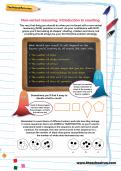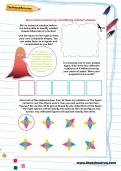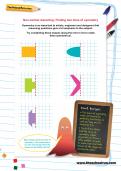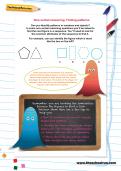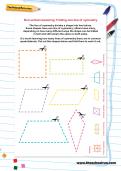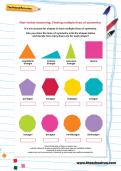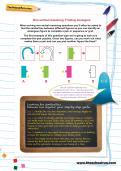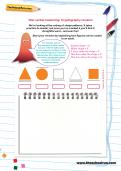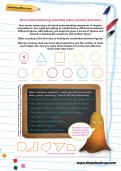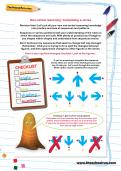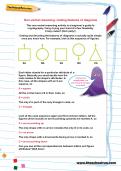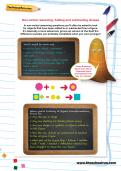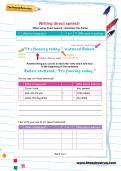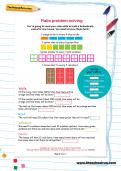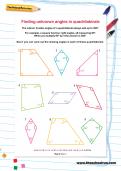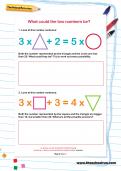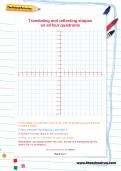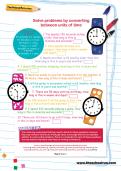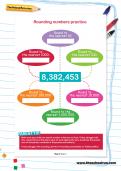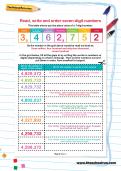11 plus worksheets
Non-verbal reasoning: Introduction to counting
The very first thing you should do when you’re faced with a non-verbal reasoning (NVR) question is count. As your confidence with NVR grows you’ll be looking at shapes’ shading, rotation and more, but counting should always be your first find-the-solution strategy. Can you find the one shape that doesn’t belong to each group?
Non-verbal reasoning: Identifying rotated shapes
Being able to identify rotated shapes takes lots of practice! Which of these shapes can be formed by shrinking the shape on the left and rotating it?
Non-verbal reasoning: Finding two lines of symmetry
Symmetry is so important to artists, engineers and designers that reasoning questions give a lot emphasis to the subject. Can you work out which of these figures has TWO lines of symmetry?
Non-verbal reasoning: Finding patterns
Can you identify patterns in numbers and objects? In some non-verbal reasoning questions you’ll be asked to find the next figure in a sequence. You’ll need to look for the common attributes of the sequence to find it. Find one figure from the group on the right that belongs to the group on the left.
Non-verbal reasoning: Finding one line of symmetry
Sometimes a non-verbal reasoning question will ask you to focus on shapes with a specific number of lines of symmetry. Which of these figures has only ONE line of symmetry?
Non-verbal reasoning: Finding multiple lines of symmetry
It’s not unusual for shapes to have multiple lines of symmetry. Can you draw the lines of symmetry onto the shapes below and decide how many there are for each shape? Then work out which of the figures has MORE THAN TWO lines of symmetry.
Non-verbal reasoning: Finding analogies
When solving non-verbal reasoning questions you’ll often be asked to find the similarities between different figures so you can identify an analogous figure to complete a pair or sequence or grid. Can you solve this ‘complete the pair’ puzzle by choosing the correct option?
Non-verbal reasoning: Cryptography revision
Are you ready to decode some codes? Work out the code for the fifth shape.
Non-verbal reasoning: Counting sides, symbols and more
Non-verbal reasoning is all about understanding sequences of shapes and patterns. You might be looking for similarities or differences between different figures. Alternatively, you might be given a series of figures and asked to complete the sequence with another figure. In this series of exercises, the first two shapes are related by a specific feature they have in common. Choose the one figure from the five choices that is most like the two figures on the left.
Non-verbal reasoning: Completing a series
Sequence or series questions test your understanding of the rules on which the sequences are built. With plenty of practice you’ll begin to see shapes within shapes and understand how sequences evolve. Find the figure that comes next in these sequences.
Non-verbal reasoning: Coding features of diagrams
This non-verbal reasoning activity is a beginner’s guide to cryptography. Fancy trying your hand at a few fiendishly tricky codes? Let’s put your code-breaking skills into practice!
Non-verbal reasoning: Adding and subtracting shapes
In non-verbal reasoning questions you’ll often be asked to look for objects that have been added to or subtracted from a figure. It’s basically a more advanced, grown-up version of the Spot the
difference puzzles you probably completed when you were younger! Apply your figure-adding and -subtracting skills to these practical exercises.
difference puzzles you probably completed when you were younger! Apply your figure-adding and -subtracting skills to these practical exercises.
Writing direct speech
Here is a helpful frame to remind you how to put together direct speech. Can you write your own direct speech sentences?
Ratio problem-solving
You’re going to need your ratio skills to build a fantastically colourful new house.
Finding unknown angles in quadrilaterals
See if you can work out the missing angles in each of these quadrilaterals.
Solve problems by converting between units of time
You'll need to convert between seconds, minutes, hours, days, weeks and years to answer these tricky questions!
Rounding numbers practice
Use this rounding numbers worksheet, created by an experienced teacher, to help your child understand how to round numbers.
Can they round up these numbers to the nearest 10, 100, 1000, 10,000, 100,000 or 1,000,000?
Can they round up these numbers to the nearest 10, 100, 1000, 10,000, 100,000 or 1,000,000?
Read, write and order seven-digit numbers
In the grid, fill all the gaps in by writing the words in numbers or digits (depending on what is missing). Then cut the numbers out and put them in order, from smallest to largest.
